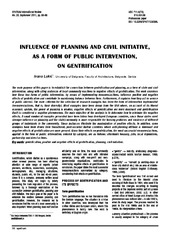Приказ основних података о документу
Influence of planning and civil initiative, as a form of public intervention, on gentrification
| dc.creator | Lukić, Ivana | |
| dc.date.accessioned | 2020-12-22T13:31:48Z | |
| dc.date.available | 2020-12-22T13:31:48Z | |
| dc.date.issued | 2011 | |
| dc.identifier.issn | 1450-569X | |
| dc.identifier.issn | 2217-8066 | |
| dc.identifier.uri | https://raf.arh.bg.ac.rs/handle/123456789/1112 | |
| dc.description.abstract | The main purpose of this paper is to establish the connection between gentrification and planning, as a form of state and civil intervention, along with citing instances of local community reactions to negative effects of gentrification. The work examines how these two forms of public intervention, by means of implementing measures/actions, influence positive and negative effects of gentrification and contribute to maintaining balance between them. Furthermore, it explains how they act in service of public interest. The main criterion for the selection of research examples has been the form of intervention implemented (measures/actions, that is, their diversity). Most examples have been drawn from the USA where, on account of its liberal economic system, the power of planning is weaker, negative effects of gentrification are more dominant and gentrification itself is considered a negative phenomenon. The main objective of the analysis is to determine how to minimize the negative effects. A small number of examples presented have been taken from developed European countries, since those states exert stronger influence on planning and the state/community is more responsible for housing problems and existence of different groups of individuals in the community. Those instances illustrate the maximization of positive effects. In addition, some examples have been drawn from transitional, post-socialist Balkan countries where anti-planning attitude is dominant and negative effects of gentrification are more present. Given their effects on gentrification, the most successful measures/actions, applied in the form of public intervention, ordered by category, are as follows: affordable housing, jobs, local regulations, partnership and direct actions. | en |
| dc.language.iso | en | sr |
| dc.publisher | Institute of Architecture, Urban & Spatial Planning of Serbia | sr |
| dc.rights | openAccess | sr |
| dc.rights.uri | https://creativecommons.org/licenses/by-nc-nd/4.0/ | |
| dc.source | Spatium | sr |
| dc.subject | Gentrification | sr |
| dc.subject | Positive and negative effects of gentrification | sr |
| dc.subject | Planning | sr |
| dc.subject | Civil initiative | sr |
| dc.title | Influence of planning and civil initiative, as a form of public intervention, on gentrification | en |
| dc.type | article | sr |
| dc.rights.license | BY-NC-ND | sr |
| dcterms.abstract | Лукић, Ивана; | |
| dc.citation.issue | 25 | |
| dc.citation.spage | 56 | |
| dc.citation.epage | 66 | |
| dc.citation.rank | M24 | |
| dc.identifier.doi | 10.2298/SPAT1125056L | |
| dc.identifier.scopus | 2-s2.0-84861424747 | |
| dc.identifier.fulltext | https://raf.arh.bg.ac.rs/bitstream/id/3840/LukicIvanaInfluence.pdf | |
| dc.type.version | publishedVersion | sr |

